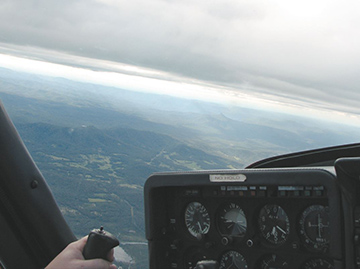- This tragic accident from the Avoidable Accident series highlights the dangers of flying visually in poor weather.

The pilot of a Cessna 337 Skymaster was conducting a private VFR flight from Moorabbin Airport, Victoria to Merimbula, NSW. The pilot, who was only qualified to operate in VMC, had indicated that he would be tracking along the coast at low level. The forecast weather included isolated showers or thunderstorms over the sea and coast, and low cloud over the sea/exposed coast. The low cloud was expected to be broken stratus between 800 ft and 2,000 ft. Visibility was quoted as reducing to 3 km in thunderstorms with rain and 6 km in showers of rain.
About 30 minutes after departing Moorabbin, people on a beach south-east of Venus Bay heard and then suddenly saw the aircraft emerge from fog at low level, flying above the water line on the beach with the wings level. Within seconds it turned right at a steep angle of bank while maintaining height and headed out to sea before disappearing from sight into the fog. The witnesses reported no apparent problem with the engines and the aircraft appeared to be under control. About 2 seconds after the aircraft disappeared from view, they heard a ‘bang’ and then silence.
Two days later, wreckage of the aircraft and three of the deceased occupants were found washed up on the beach. The pilot was not found.
The investigation concluded that while manoeuvring over water at low level in conditions of reduced visibility, the pilot probably became spatially disorientated and inadvertently descended into the water.
By turning away from the land in the foggy conditions, the pilot would have encountered a featureless, grey environment with no visible horizon, making it extremely difficult for him to judge the aircraft’s attitude and/or height.
It should be accepted that flying under the VFR will not always enable you to reach your planned destination. Weather often does not act as the forecast predicts.
It should be accepted that flying under the VFR will not always enable you to reach your planned destination. Weather often does not act as the forecast predicts. You must have alternatives available and you must be prepared to use them — even if it means returning to your departure point.
In forecast marginal weather, careful pre-flight planning is essential and must include a thorough analysis of the latest weather forecasts and consideration of your available options. Those options should be evaluated while en route to ensure you have an alternative course of action available which provides for a safe landing.
Based on ATSB investigation AO-2007-061 - Collision with water, approx. 24 km south-east of Inverloch, Victoria, on 17 November 2007, Cessna C337G, VH-CHU
Know your personal minimums
When deciding on whether it is safe to fly you should consider not only the route to be flown, the prevailing weather and aircraft serviceability, but your own physical and emotional fitness and flying experience. In other words, to be a competent pilot you must know and fly within your own limitations. Adhering to a pre-flight ‘personal minimums’ checklist will go a long way toward keeping you safe. For example, the decision to turn back or divert will be easier if you have decided in advance what your personal minimum VFR flying altitude will be. That minimum altitude may well be much more conservative than the legal requirement.
A ‘personal minimums’ checklist, included in the CASA publication ‘Flight Planning — always thinking ahead’, will help you control and manage risk by identifying risk factors and allowing you to fly with less stress and less risk.
Read more about Accidents involving Visual Flight Rules pilots in Instrument Meteorological Conditions.


